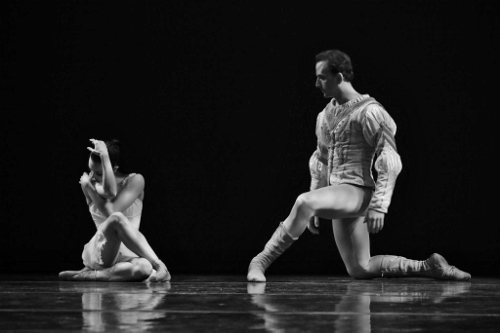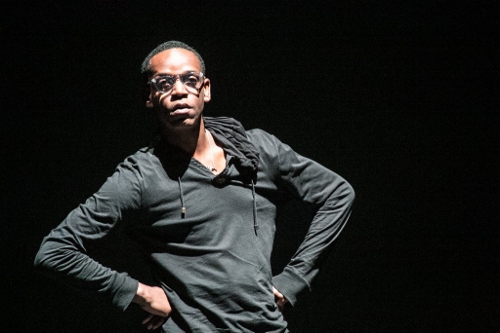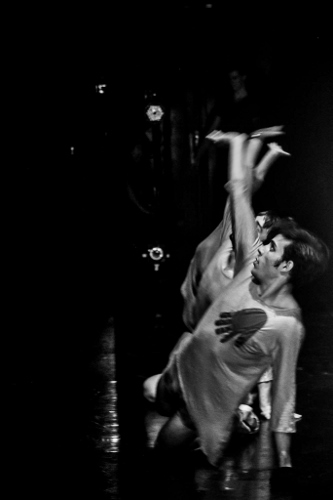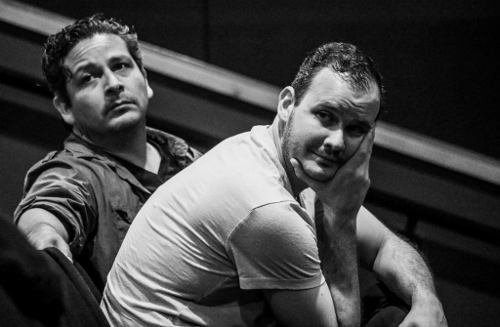|
 |
|
|
 |
 |
When it comes to all-star dance benefits, few outside the nation’s major metropolises pack in as much talent and great dancing as Columbus, Ohio’s The Benefit. Curated by former BalletMet stars Jimmy Orrante and Attila Bongar, the annual event, now in its fourth year, benefits The Central Ohio Chapter of the National Hemophilia Foundation. It’s a charity close to Orrante’s heart as his son Isaac lives with the disease. The expanded event on Sunday, May 21, 2017 was held for the first time at downtown Columbus’ newly renamed Jo Ann Davidson Theatre (formerly the Capitol Theatre) at the Vern Riffe Center and featured dancers and choreographers from Miami City Ballet, Cincinnati Ballet, Milwaukee Ballet, Rochester Ballet, BalletMet and Columbus Dance Theatre. In addition, Camarata, a multi-piece orchestra made up of musicians from the Columbus Symphony Orchestra and led by CSO principal cellist Luis Biava, played live accompanying many of the dance and music works on the program. Milwaukee Ballet stars and husband and wife Nicole Teague Howell and Patrick Howell in the second act pas de deux from Michael Pink’s Swan Lake opened the program. Dancing to Tchaikovsky’s music for the ballet, the pair as Odette and Prince Siegfried moved crisply and with lovely command in Pink’s neo-classical choreography that was more akin to a pas de deux from Romeo & Juliet than Swan Lake. Baritone singer Robert Kerr then performed an animated rendition of the aria “Non più andrai” from Mozart’s opera The Marriage of Figaro. It was followed by “Regard,” the first of two ballets on the program by Orrante. Set to the second movement of Rachmaninov’s Piano Concerto No. 2, which was famously used by singer Eric Carmen for his 1975 hit “All by Myself,” Orrante’s pas de deux featured Miami City Ballet principal soloist Lauren Fadeley and BalletMet’s Jarrett Reimers in back and forth choreography full of elegance and grace. Fadeley and Reimers moved with the ease of spirits floating weightlessly about the stage and in and out of marvelously-crafted lifts, turns, and carries. Of the evening’s many magical moments, one of its most striking came courtesy of former Alvin Ailey American Dance Theater dancer Marcus Jarrell Willis’ solo “A Caretakers Vow” (Excerpt). Performed to recorded music by British soul singer-songwriter Laura Mvula, the solo, according to Willis, explores the uncertainty he felt about his future after leaving Ailey and how his friends encouraged and lifted him up. It began with Willis in spotlight on his knees and using a myriad of face, hand, arm, and body gestures in concert with Mvula’s song “Show Me Love” to convey his feelings and emotions. A tour-de-force of tightly contained brilliance, Willis’ dancing was fluid, dramatic and poignant. Concluding the program’s first half was the 3-part “Voyager.” The largest and most stylistically diverse of the on the program, it was inspired by music selections contained in NASA’s Golden Records included on the Voyager 1 and 2’s interstellar missions. It began with Columbus’ COSI Science Center chief scientist Paul Sutter giving a brief overview of the Voyager missions and the Golden Records that led into the work’s first section; Orrante’s “Dark Was the Night Cold was the Ground” set to Blind Willie Johnson’s blues song of the same name performed live by North Carolina bluesman th’ Bullfrog Willard McGhee. In it, McGhee sat center stage on a stool as six female dancers surrounded him crisscrossing the stage in small waves of jumping, twisting and whirling movements. More narration by Sutter then gave way to a thoughtful solo by kathak dancer/choreographer Mansee Singhi performed to “Jaat Kahan Ho” a traditional Indian song sung by Surshri Kesar Bai Kerkar, and “Bach Brandenburg Concerto No. 2,” a new ballet by former Columbus Dance Theatre dancer Christian Broomhall. Full of whimsy, Broomhall’s work was an ear-to-ear grin-inducing delight. Its eight dancers (5 men, 3 women) pranced and cavorted about in what felt like a contemporary dance jig. At times bird-like, the dancers flapped their arms and fluttered their hands as if to take flight and mimicked pecking at each other. Broomhall, who impressed at 2016’s The Benefit with his ballet “She is,” once again showed why he is a choreographer to watch and one whose ballets need to be in the repertory of more professional dance troupes. The program’s second half opened with a stirring interpretation of Edvard Grieg’s “Holberg Suite” by Camarata. It was followed by Bongar’s mini-story ballet “63,” set to music by composer Alexander Scriabin. In it, Bongar sought to capture the emotions he perceived from seeing a photo of Jacqueline Kennedy and her daughter standing in front slain President John F. Kennedy coffin in 1963. The ballet showed mother, father and daughter figures facing a similar type of emotional distress. It was danced by. And while Scriabin’s dark music and dancers Fadeley, BalletMet’s Michael Sayre and BalletMet Dance Academy student Isabelle LaPierre’s emotional outpourings of tumult captured Bongar’s intent, the choreography lacked originality and the ballet on the whole came off as overly melodramatic. Next, Cincinnati Ballet soloist James Cunningham’s trio “Mordent” lifted the mood with a ballet that was chock-full of thrilling choreography and adroit dancing. Set to Beethoven’s Piano Trio in C minor, Op.1 No.3 and titled after the musical term meaning a melodic embellishment, the ballet’s trio of dancers from Cincinnati Ballet each sported an unusual costume embellishment. Corps de ballet dancer Taylor Carrasco wore one black glove and a blood red handprint on his shirt, apprentice dancer Michael Mengden wore one red glove and face paint, and senior soloist Melissa Gelfin was outfitted with two different colored pointe shoes and wore one white sock. Whatever the intended meaning of those embellishments, they further added to a ballet dense with visual marvels. Following in quick succession were McGhee performing his gravely-great vaudeville tune “Bullfrog,” Rochester Ballet’s Ben Rabe showing of his leaping ability in the Cossack dance “Gopak,” choreographed by R. Zakharov and pianist Tyrone Boyle dazzling in his composition “Carousel in C Major”. The first of two ballets to close out the 2-hour program was Kristopher Estes-Brown’s group ballet “The Sum of,” danced to music performed live by Columbus indie rock band The Wind and the Sea. Estes-Brown’s choreography for it, while not particularly inventive, matched the drive of music and gave the ballet a rock-show feel. Capping The Benefit in style was Bongar’s powerfully beautiful version of the pas de deux from the ballet Spartacus. Performed with passion by BalletMet’s Jessica Brown and Romel Frometa, the pas de deux epitomized the program’s high level of artistry on all counts. With its diversity in dance and music styles, types of choreographic works, entertaining and skilled performers as well as post-performance reception with the performers, The Benefit was a steal at $30 a ticket. Add to that the money raised going to worthy cause and you have a program that no dance lover in their right heart and mind should miss.
 From 2017's 'The Benefit': Milwaukee Ballet’s Nicole Teague Howell and Patrick Howell in the second act pas de deux from Michael Pink’s “Swan Lake.” Photo © & courtesy of Bullfrog Willard McGhee |
|
 From 2017's 'The Benefit': Dancers in Christian Broomhall’s “Bach Brandenburg Concerto No. 2.” Photo © & courtesy of Bullfrog Willard McGhee |
|
 From 2017's 'The Benefit': Marcus Jarrell Willis in “A Caretakers Vow.” Photo © & courtesy of Bullfrog Willard McGhee |
|
 From 2017's 'The Benefit': (l-r) BalletMet’s Jessica Brown, Columbus Dance Theatre’s Kerri Riccardi and BalletMet’s Karen Wing in Christian Broomhall’s “Bach Brandenburg Concerto No. 2.” Photo © & courtesy of Bullfrog Willard McGhee |
|
 From 2017's 'The Benefit': Miami City Ballet principal soloist Lauren Fadeley and BalletMet’s Michael Sayre in Attila Bongar’s “63.” Photo © & courtesy of Bullfrog Willard McGhee |
|
 From 2017's 'The Benefit': Dancers in Cincinnati Ballet soloist James Cunningham’s “Mordent.” Photo © & courtesy of Bullfrog Willard McGhee |
|
 From 2017's 'The Benefit': ‘The Benefit’ organizers Jimmy Orrante and Attila Bongar. Photo © & courtesy of Bullfrog Willard McGhee |
|
 From 2017's 'The Benefit': Columbus Symphony Orchestra’s Luis Biava conducts Camarata. Photo © & courtesy of Bullfrog Willard McGhee |
|
|
|









